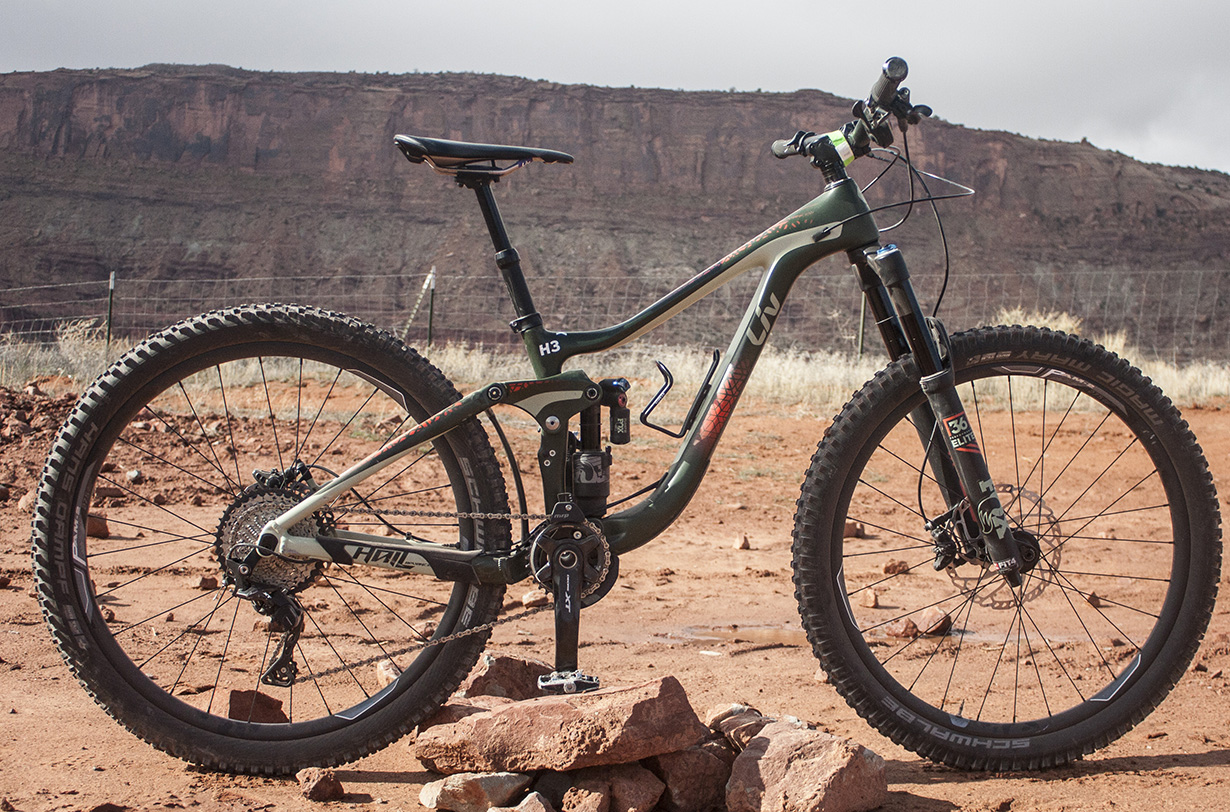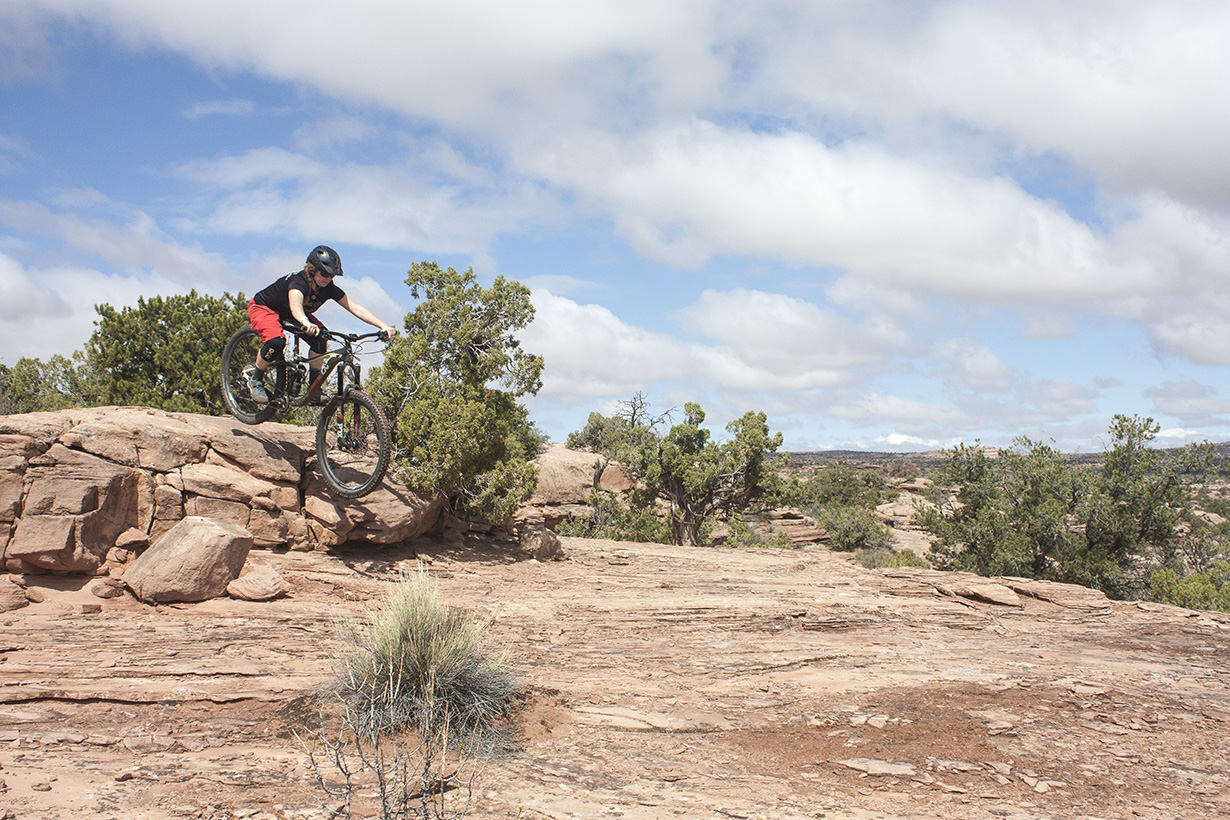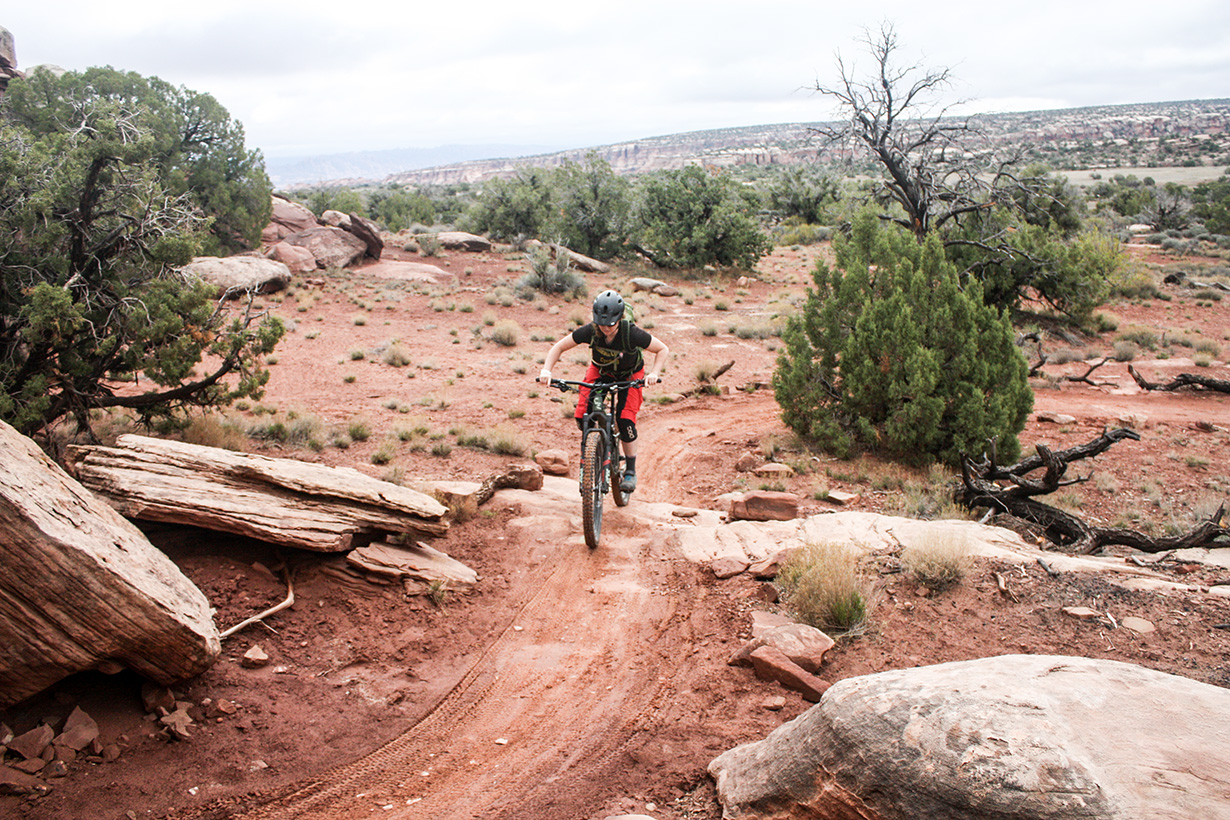Liv Hail Advanced 1

Size Tested: XS
Build Overview:
-
- Drivetrain: Shimano SLX / XT
- Brakes: Shimano SLX
- Fork: Fox 36 Talas Performance Elite
- Rear Shock: Fox Float X2 Performance Elite
- Wheels: Giant P-AM2
- Seatpost: Giant Contact SL Switch Trail
- Wheels: 27.5′′
- Travel: 160 mm rear / 160 mm front
- Blister’s Measured Weight: 30.0 lbs without pedals
MSRP: $5,350
Reviewer: 5’2”, 125 lbs.
Test Location: Moab, Utah
Note
We swung through Outerbike in Moab a few weeks ago to hang out, ride some bikes, and partake in the good times that happen when bike people gather together in the desert.
If you don’t already know about Outerbike, you should; it’s a great opportunity to demo new bikes on some great trails. There are three Outerbike events throughout the year — Moab in the spring; Crested Butte in the summer; and Moab again in the fall. Each event lasts 3-4 days, and you can get more information at outerbike.com.
So we had three days to ride some of this year’s new bikes on a smattering of Moab’s best trails. And while it was a great opportunity to learn a good bit about a number of new bikes (including the one reviewed here), we only rode these bikes for a few hours each, so keep in mind that this isn’t our normal full-scale review.

Intro
The Liv Hail is new for 2017, and was designed from the ground up as a women’s-specific, all-mountain bike. Although it has the same amount of travel as the Giant Reign (Liv is Giant’s women’s-specific brand of bikes), the Hail is not a mini version of the Reign. The Hail was designed to optimize performance for riders who want to charge on descents but are lighter and therefore need a more nimble bike in many situations. I found the Hail to be stable and plush on descents, but to lack the playfulness and precision to make it an amazing all-around trail bike.
The Hail Advanced comes in two versions: the carbon-framed “Advanced 1” (reviewed here), and the higher-end “Advanced 0” that comes with a nicer spec. There is also an all-aluminum Hail frame that comes in two builds, the Hail 1 and Hail 2.
Frame and Geometry
The Hail Advanced has a carbon front triangle and rocker link paired with an aluminum rear triangle. The new carbon rocker link was designed for the 2017 bike to increase stiffness over the old aluminum rocker link.
The Hail uses a tweaked version of Giant’s Maestro suspension that’s found on the ‘17 Reign and Trance. The bike is designed around a metric shock that’s mounted trunnion style. This allows for a longer shock stroke to be used, which decreases the leverage ratio. Liv also claims that the mounting placement of the shock lowers the center of gravity on the bike, making it ideal for women since we generally have a lower center of gravity than men.
Liv put a lot of effort into designing a women’s-specific geometry from the ground up for the Hail. They incorporated a low standover, a lower center of gravity, and increased maneuverability at slow speeds in a 160 mm trail bike. At first glance, some of these features make the geometry of the Hail look a bit confusing. Its long reach and wheelbase fall in line with the current enduro bike trend, but the 66 degree head angle is a bit steeper than many bikes in the same 160 mm travel category (including the 65 degree head angle on the Giant Reign). And the Hail’s bottom bracket is a touch higher. These discrepancies aren’t as noticeable when riding the bike as I expected they would be. Instead, the Hail simply feels as though it was primarily made to steamroll trails at high speeds.
Fit
Liv dismissed the idea that women need an especially small reach on their bikes, and instead choose to go with an overall long frame. At 5’2” (167 cm), I fall within the Extra Small size on Liv’s sizing chart, just under the recommended height for the Small. So I chose to ride the Extra Small, and that proved to be a very good decision. I found that the size XS Hail fit me similarly to many size Small unisex bikes.

The reach ranges from 404 mm for the Extra Small to 450 mm for the Large. A 404 mm reach on a size XS is longer than average, with many bikes in this size (such as the Yeti Beti SB5 and Pivot Mach 6) having reach numbers closer to 380 mm. At 570 mm on the Extra Small, the toptube of the Hail is also fairly long, and is in the ballpark of many size Small bikes (such as the Santa Cruz Bronson).
On the XS Hail Advanced 1, I felt stretched out but not too uncomfortable while climbing in the saddle once I set the saddle as far forward as it goes. Again, I’m 5’2”, and I set up the bike to be as short as possible without swapping stems or other components. Even though Liv includes riders down to 4’10” on the size chart, I think it’ll feel like a big bike for riders shorter than me.
Riding on the Hail definitely made me feel like I was “in” the bike, rather than “on” it. This made the bike feel more conducive to maintaining stability through technical sections, rather than encouraging me to play around on extra credit lines.
I found one significant problem with the fit of the Hail, which is that the seatpost cannot be inserted very far into the seat tube. Being 5’2” on a size XS women’s-specific bike that is designed for riders who are as short as 4’10”, I should be able to run the stock 100 mm seatpost without a problem. However, the post at maximum insertion topped out at about 1 cm too high for me. Many other men’s size Small bikes (like the YT Capra and Ibis Mojo 3) accommodate dropper seatposts much better for someone my size. Having a women’s-specific bike that doesn’t remedy this problem is a pretty big issue.
Build
The Hail Advanced 1 is outfitted with Fox Performance Elite suspension, Shimano SLX brakes and SLX/XT drivetrain, and is rounded out with an in-house Giant cockpit, wheelset, and dropper post. The higher-end Hail Advanced 0 is priced at $8250, and gets a RockShox Lyrik fork, Deluxe RT3 shock, Sram Guide Ultimate brakes and XO1 drivetrain, and Giant accessories with a lot more carbon bits and pieces. Both bikes are stocked with a Schwalbe Magic Mary tire up front, and a Hans Dampf in the back.
The drivetrain, brakes, suspension, tires, and cockpit components all work well and are great choices for this bike. Some riders might like to see a few component changes, namely the dropper post and wheelset. The seatpost goes up and down as it should, but has quite a bit of the lateral play that is common with the Giant Contact post. The wheelset is not extremely stiff and the hub does not have great engagement, which was more apparent than normal on the techy climbs in Moab.
Liv spec’ed the Hail with 800 mm wide, 31.8 mm handlebars on all sizes, so no one would be stuck with a bar that is too narrow. Most riders will want to immediately cut this, but it’s nice to have the option of running any width. The bike I rode had 760 mm wide pre-cut bars, which helped dial the fit of the bike.
Climbing
The Hail is intended to be a downhill-oriented trail bike that climbs well, but really excels on the descent. This was very obvious on the rolling trails of the Mag 7 trail network in Moab. I found that the Hail is not great at climbing, but it gets the job done. At 30 lbs for an Extra Small, it is relatively hefty and seems to wallow in the middle of its travel, so the lack of power transfer is noticeable during hard out-of-the-saddle pushes up steep or technical sections of trail. On paper, the Hail is a very progressive bike, but it is probably necessary to take the time to set up the shock so that it is supportive through the mid-stroke.
The best trail bikes are great at climbing even with their suspension is set in “descend” mode, but I found that the Hail climbs just well enough to get to the next descent. To improve climbing performance, the Hail’s suspension can be changed by putting the shock in “climb” mode and dropping the Talas fork down to 130 mm. This is not usually worthwhile for short climbs in rolling terrain, but would improve sustained climbing.
One aspect of the Hail that improved its technical climbing capabilities is its higher-than-normal bottom bracket (the BB drop is only 5 mm). This makes pedal strikes while climbing very rare. I found this geometry tweak to be nice while riding in Moab, but perhaps unnecessary for most riding locations due to the already shorter 170 mm cranks spec’ed on all sizes of the Hail. But even if it’s most likely unnecessary, the Hail’s higher BB did not have a noticeable negative effect on the stability of the bike descending.
Descending
On descents, the Hail tracks the ground very well, steamrolling rocks rather than popping through them. This makes the bike feel sluggish at slow speeds, but very stable and competent once it gets going. I found that I had a larger margin of error while riding the Hail at speed, even compared to a bike with slightly more travel (the YT Capra), because the Hail eats up square-edged hits and awkward compressions.
But the plushness and stuck-to-the-ground feeling of the Hail hinders the playfulness and low speed tech capabilities of the bike. Popping off rocks and pushing out of corners became much more of a chore on the Hail, as it wallowed in the middle of its travel instead of offering support.
I found the recommended suspension settings (over 30% sag rear, 25% front) to be way too soft, and I started my ride bottoming out on any substantial hit or compression. I added air to the shock throughout the ride to where I was riding at about 25% sag in the rear and 18% up front, but I was still pushing through most of the travel on medium-sized hits. I didn’t have time to play a bunch with the suspension adjustments, but I think a combination of compression adjustments and volume reducers would likely go a long way toward resolving this.
Bottom Line
Liv tossed out the “shrink it and pink it” philosophy when designing the Hail, and instead put together a well-thought-out spec and an aggressive women’s geometry to make a trail bike that loves to go fast down hills and still manages to climb back up to the top. The bike has some nice features for smaller riders, but didn’t quite solve the specific problems I most often have with unisex bikes, namely having enough clearance to run a dropper post and feeling stretched out on seated climbs.Still, after some attentive suspension setup, the Hail is certainly a confidence-inspiring bike for riders who prioritize fast and aggressive descending over playful riding.
Still, after some attentive suspension setup, the Hail is certainly a confidence-inspiring bike for riders who prioritize fast and aggressive descending over playful riding.
